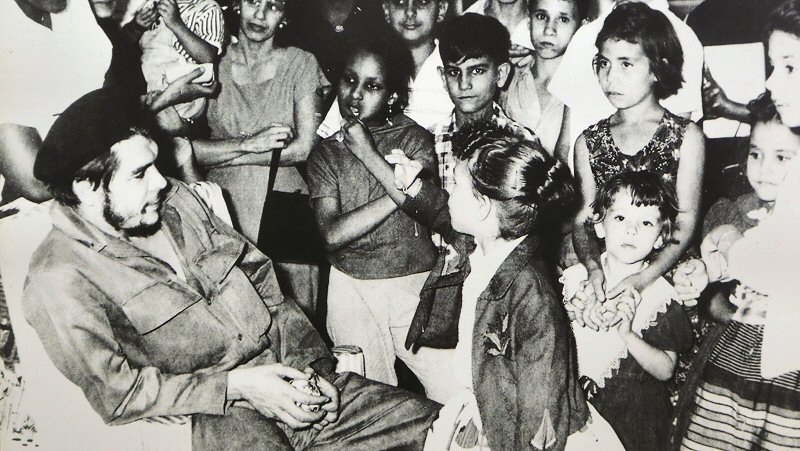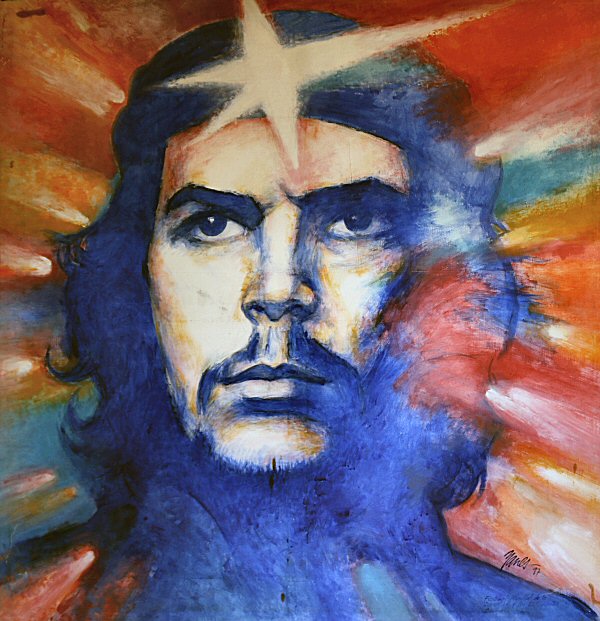
The Centro Cultural Casa del Che is
located on the hill La Cabaña overlooking the city. The
entire building is painted in white, so that it can be
easily distinguished from far away. The signature of Che
Guevara in big format is adorning the façade of the
two-floors building. On the outer wall you will see the
plaque that was nailed in 1970, when the house was opened as
House Museum, and two photos, witnessing the unveiling of the
plaque.
A big colored portrait of Che welcomes you
at the entrance and a huge bust of Che greets you at the
doorway. On the wall of the entrance hall you will see an
inscription with a sentence of Che: Desde ahora no
consideraría mi muerte una frustración, apenas, como Hikmet:
sólo llevaré a la tumba la pesadumbre de un canto inconcluso.
(From now on, I would not consider my death a frustration,
just like Hikmet: I will only bring to the grave the sorrow
of an unfinished song). Here, Che refers to a poem written
by the Turkish poet Nazım Hikmet in the Prison of Bursa,
Turkey in 1933, when he was on trial that might lead to his
execution. The poem has the title ‘Letter to My Wife’.
The walls are covered with several
unpublished photos of Che Guevara with Fidel Castro, Camilo
Cienfuegos, Olo Pantoja, Pablo Rivalta Pérez, Ramiro Valdés
Menéndez, Harry Villegas Tamayo, some soldiers of column 8
Ciro Redondo including Juan Alberto Castellanos, Aleida
Match, and a group of children of the children’s theatre Los
Barbuditos. The photos that show Che reading a book, are
rather impressive.
The bedroom gives some hints about the
gusto of Che Guevara. On the commode with mirror you will
see a box of Montecristo, Che’s favorite cigar, and the
thermos, the calabash gourd and the bombilla that Che used
to drink his favorite drink El Mate. Mate is a caffeine-rich
infused drink of Paraguay origin, also known as cimarrón. It
is prepared by steeping dried leaves of yerba mate in hot
water and is served with a metal straw from a shared hollow
calabash gourd. The straw is called bombilla in Spanish. The
straw is traditionally made of silver. The gourd is known as
a mate or a guampa. Even if the water is supplied from a
modern thermos, the infusion is traditionally drunk
from mates.
The chess room with exposed boards seems
to wait for the chess players. A photo of Che taken with the
Russian chess grandmasters Vasily Smyslov and Mark
Evgenievich Taimanov during the chess tournament, held in
memoriam of Ajedrez Capablanca in 1964, can be seen on the
wall. Ajedrez Capablanca (1888-1942) was the Cuban chess
champion that was also world champion during 1921-1927. He
was nicknamed Mozart of the Chess.
The protocol room is well equipped. It is
used for conferences, commemorative events and video
projections in a cozy atmosphere.
One of the striking parts of the house is
the exhibition room, El Mate. The objects of the guerillas
that they used in Bolivia in 1960s, such as the typewriter
of Coco Peredo that was used for the revolutionary
propaganda, the camera, the radio, the porcelain plate, the
metal flask, the machine used to grind the flour to make
pasta, the hunting
trap, the leather briefcase used to store the funds of the
guerillas, the boots of Guido Álvaro Peredo Leigue, the
bombilla to drink the infusion of mate and the leather pouch
of Haydée Tamara Bunke Bider, the cinch to ride a horse
during the fight and the Mamiya 16 automatic
subminiature camera, are exhibited in this room.

